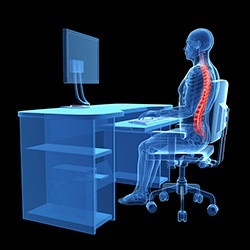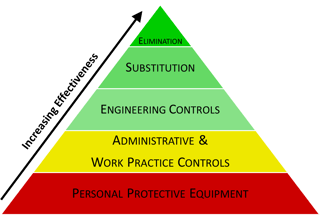 Carpal tunnel syndrome, tendinitis, rotator cuff injuries, muscle strains, and other work-related musculoskeletal disorders (MSDs) such as these can be prevented. By implementing ergonomic solutions in the workplace, you can help reduce the number and severity of work-related MSDs.
Carpal tunnel syndrome, tendinitis, rotator cuff injuries, muscle strains, and other work-related musculoskeletal disorders (MSDs) such as these can be prevented. By implementing ergonomic solutions in the workplace, you can help reduce the number and severity of work-related MSDs.
After identifying ergonomic hazards by reviewing injury records, observing workplace conditions, and initializing early reporting – it is time to look at potential solutions you can implement in order to reduce, control, or eliminate work-related MSDs.
Hierarchy Of Controls
Before discussing controls for ergonomics issues, it is important to take a step back and think about the hierarchy of controls. OSHA considers this hierarchy a way to determine what controls would be feasible and most effective.
 Eliminate – This is the preferred method and most effective solution. It is controlling the hazard at the source.
Eliminate – This is the preferred method and most effective solution. It is controlling the hazard at the source.- Substitute – If elimination is not possible, consider substituting or replacing the known hazard with a material, process, or equipment that is less hazardous.
- Engineer – A strategy involving denying access to the hazard by installing physical barriers. This could be a redesign of equipment or work processes to reduce the frequency of performing dangerous tasks. Or the isolation of the hazard by installing screens or barriers around hazardous areas.
- Administrative – When exposure to the risk is not, or cannot, be minimized by other means, you should introduce safe work practices to reduce the risk.
- Personal Protective Equipment – Introduce PPE to increase protection and when other measures are not practical.
Engineering Controls
When looking at ergonomic issues that cannot be eliminated or substituted, engineering controls are the most desirable way to control hazards. Consider the following examples:
- Redesign workstations and tools to best accommodate all workers.
- Modify workstation lighting.
- Control or remove worker exposure to harmful vibrations.
- Automate processes to reduce worker exposure to repetitious movements.
- Install mechanical lifting devices that limit workers’ physical stresses on the body.
- Avoid situations where employees must use a pinch grip to handle material. If manual material handling must be performed, provide lift points that give workers an easier grasp.
- Reduce the weight of a load to limit force exertion.
- Reposition a work table to eliminate a long/excessive reach and enable working in neutral postures.
Administrative And Work Practice Controls
Where engineering controls are unable to be implemented, it may be appropriate to consider administrative or work practice controls which establish efficient processes and procedures. Consider the following examples:
- Require a two person lift when materials exceed a certain weight, or are awkward in shape/size.
- Establish a job rotation system so workers are rotated away from tasks to minimize the duration of continual exertion, repetitive motions, and awkward postures, allowing the employee to use different muscle groups.
- Properly use and maintain pneumatic and power tools.
Personal Protective Equipment
Though they have limited effectiveness in controlling ergonomic hazards, personal protective equipment is another control that can be utilized. Consider the following examples:
- Use padding to reduce contact stress with hard, sharp, or vibrating surfaces, such as padded gloves, elbow pads, and knee pads.
- Wear good fitting thermal gloves to help with cold conditions while maintaining the ability to grasp items easily.
- Wear proper fitting, slip-resistant footwear that will ensure solid footing and prevent slips, trips, and falls.
Identifying ergonomic hazards is just the first step of the process. Next you need to explore potential solutions to reduce, control, or eliminate work-related MSDs to help improve workplace safety.



